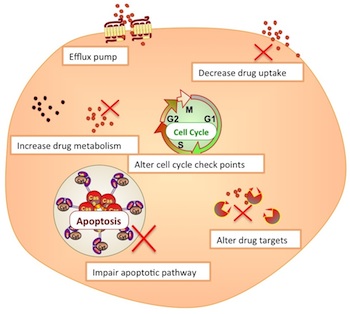Major Features of CancerDP
Drug Prioritization:
Drug prioritization modules allowed users to priortize drugs on the basis SVM models. These SVM models were developed on four types of genomic features viz. mutation, variation, expression and copy number variation (CNV). These genomic features wer e used as input features to model the drug response of 24 anticancer drugs.- Mutation based SVM models were developed on the mutation status of 388 cancer genes (extracted from CCLE). User can either give the mutation status of these 388 genes of they can also give the mutation status of lesser number of genes, but at the cost of performance.
- Variation based SVM models were developed on the normal variations of these cancer genes reprted in 1000 Genome project.
- Expression based SVM models were developed on the expression status of 1200 cancer genes in around 900 cancer cell lines.
- CNV based SVM models were developed on the copy number status cancer genes in around 900 cancer cell lines.
- Hybrid SVM models were developed using all the four genomic features together to take their cumulative advantage.
Users can use any of these models for drug prioritization by providing their respective information.
Drug Calculator:
Drug calculator modules will help the users to select the best drugs on the basis of genomic features viz. mutation, variation, expression and copy number variation (CNV). But these module do not depend upon SVM models for this purpose.- Mutation based calculator is based on the probability of finding a gene mutated in resistant or sensitivie cancer cell lines. Users have to provide the cancer gene names and drug calculator will calculate the the average IC50 in resistant and sensitive cancer cell lines along with their difference in IC50 and associated P-value.
- Variation based calculator is same as mutation based calculator except it uses normal variation instead of mutation.
- Expression based calculator is based on the differential expression of cancer genes in resistant and sensitive cell lines. The purpose of Expression-based drug Calculator is to find out the best drug for a patient based on expression of query gene.
- CNV based calculator is based on the on the difference of CNV between resistant and sensitive cell lines. The purpose of CNV-based drug Calculator is to find out the best drug for a patient based on Copy Number Variation of query gene.
Signatures:
Signature modules will help users to find out the signinficane of a gene in determining the drug response.- Mutation based signature module determine the importance of a gene mutation on a drug response. This tool is based on the difference of IC50 of mutated and normal cell lines for that particular gene.
- Variation based signature module determine the importance of a normal gene variation on a drug response. This tool is based on the difference of IC50 of variant and normal cell lines for that particular gene.
- Expression based signature module determine the importance of a gene expression (low or high) on a drug response. his tool is based on the difference of IC50 of cell lines having high and low expression for that particular gene.
- CNV based signature module determine the importance of a copy number variation on a drug response. This tool is based on the difference of average IC50 of cell lines having CNV value <=-1 or >=+1 for that particular gene.



